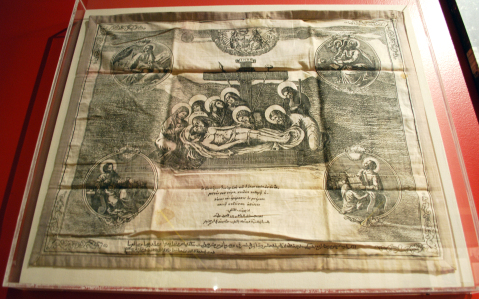This object is an Antimen or Antimension which translates to “instead of the table” and is used in Orthodox Christian churches. It is an authorizing document printed on cloth that allows the priest to celebrate the Divine Liturgy. Antimens could be issued by a bishop directly to a priest, or to the church itself. If the priest was issued the antimen he would travel with it wherever he went to serve; while an antimen issued to the church would stay with on altar of the church. This particular antimension belonged to Rev. Nicholas Nahas who ministered for 47 years with it throughout North and Central America.
The altar table is the center of the church and its ceremonies. Because of this, the antimension plays an important role as it covers the altar. The antimension is typically made of either linen or silk. Typically antimensions are decorated with images of the entombment of Christ, the four Evangelists (Matthew, Mark, Luke, and John) and scriptural passages related to the Eucharist. The antimension usually has a relic sewn inside of it as well. Relics are items connected to important religious figures, events, or objects. In this antimension there originally was a bone fragment from a saint. Now there is a shard of gravel from the original St. Michael Church located in Beaumont, Texas.
Although the antimension plays a role in every service, it is especially important when celebrating the Eucharist. In fact, the Eucharist cannot be celebrated without the antimension. The Eucharist is a religious rite that began with the Passover meal which is a holiday in Judaism. Connections are also made to Jesus Christ and his disciples who shared a Passover meal before his death. Christian tradition states that during the meal, Christ symbolically gave his disciples his body and blood in the form of bread and wine. Today, many Christian denominations participate in the ritual of the Eucharist, or the Holy Communion, in which parishioners take a sip of wine and piece of wafer as Christ’s body and blood on Sundays.
The Orthodox Church traces its history back to the disciples of Jesus who appointed bishops to stay and manage the growing number of churches. Eventually this turned into a hierarchy, as bishops soon needed help to manage the churches in their area and they designated deacons and priests. At this point, Christianity was a single entity expanding across Europe and into the East. By around 750 A.D. the Church was facing problems as it grew and the East and West began to differ in the language used as well as customs. It wasn’t until 1058 though that the Western Roman Catholic Church and the Eastern Orthodox Church officially split. As of 2010, 260 million people, or 11.9% of the Christian population worldwide, practices Orthodox Christianity.
